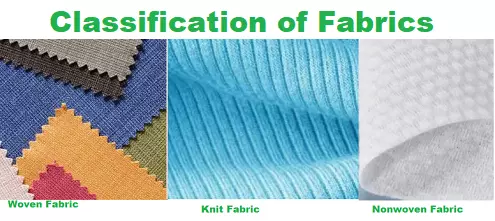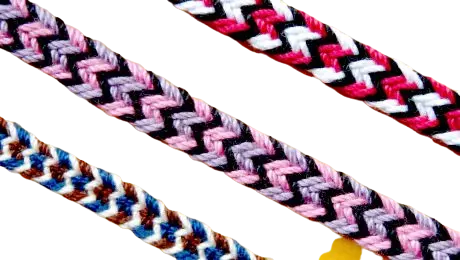Textile fabric is made of textile yarn. Two or more sets of yarn produced a fabric by interlacing , interloping or other process. Who does not know fabric or has not heard the word “Fabric”? Fabric is a textile material, we wear clothes made of any type of fabric. Fabrics are made by weaving or knitting fibers together to form a flat or three-dimensional material. Woven fabrics are made by interlacing horizontal and vertical threads, while knitted fabrics are made by interlocking loops of yarn or thread. The type of fabric used in a product is often chosen based on the properties it offers, such as its strength, flexibility, durability, and resistance to moisture. Fabrics uses for clothing, household items like towels and sheets, and industrial products like tires and upholstery. This article is about the Classification of Fabrics and their uses in textiles.
Classification of Fabrics
Fabric can be classified in many ways easily, that are manufacturing process, fabric structure, and construction. Now the question is fabric is produced in which way, is that through weaving, knitting, by the chemical or heat process? And the structure or constructive issues thread interlacement, interloping, glue, or chemical bonding. So the fabrics are classified into 4 types. Those are 1. Woven Fabric, 2. Knit Fabric, 3. Nonwoven Fabric, 4. Braided Fabric.

Woven fabric
Woven fabric is produced through the weaving process in a handloom or power loom. Warp and weft yarn interlacing together during the weaving process. Both warp and weft yarn can be made of either natural or synthetic fiber. Warp yarn uses in the length direction and weft yarn is weaved in the width direction. Woven fabric is more durable than any other fabric.
Knit Fabric
Knit Fabric is also known as knitted fabric. The knitting machine produces knit fabric by interloping of yarn set. Knitted fabric is very comfortable to wear. Basically knitted fabric is two types; warp knit and weft knit. Almost 80% clothing of humans can be made of knit fabric; t-shirts, trousers, socks, and sweaters. They are flexible and stretchy, which makes them ideal for clothing that needs to fit a wide range of body shapes and sizes, such as socks, sweaters, and undergarments. Knitted fabrics are also used for household items like towels and blankets, as well as in the automotive and medical industries.
Non woven Fabric
Non-woven is also known as felted fabric. A totally very different fabric than woven and knit. It is produced by bonding together fiber or filament in chemical, mechanical, heat, or solvent treatments. Nonwoven is a part of our daily life such as tissue, mask, blanket, carpet, etc. are made of nonwoven.They are commonly used in a variety of products, including hygiene products, medical supplies, protective apparel, filters, and insulation.

Braided Fabric
“Braided fabric” produce by twisting three or more yarns much like a hair braid. It suits the purpose of the maker. The yarns are interlaced in any direction. It started as a handicraft for making decorative fabrics. As braiding fabric manufacturing is very easy, now uses in almost everywhere have use of fabric. Uses of Braided fabrics in the garments industry, Automotive industry, Industrial protective wear and accessories, Activewear, and Surgical belt.
List of Woven, Knit, and Nonwoven Fabrics
| SI | Woven Fabric | Knit Fabric | Nonwoven Fabric |
| 1 | Buckram Fabric | Flat or Jersey Knit Fabric | Carpet/carpet backing Cloth |
| 2 | Cambric Fabric | Purl Knit Fabric | Diaper |
| 3 | Casement Fabric | Rib Stitch Knit Fabric | Surgical Mask |
| 4 | Cheese Cloth | Interlock Stitch Knit Fabric | Tissue paper |
| 5 | Chiffon Fabric | Double Knit Fabric | Blanket |
| 6 | Chintz Fabric | Warp Knitted Fabric | Surgical Gown |
| 7 | Corduroy Fabric | Tricot Knit Fabric | Interlining |
| 8 | Crepe Fabric | Raschel Knit Fabric | |
| 9 | Denim Fabric | Cable Knit Fabric | |
| 10 | Drill Fabric | Bird’s Eye Knit Fabric | |
| 11 | Flannel Fabric | Pointelle Knit Fabric | |
| 12 | Gabardine Fabric | Intarsia Knit Fabric | |
| 13 | Georgette Fabric | Jacquard Knit Fabric | |
| 14 | Kashmir Silk Fabric | Knitted Terry Fabric | |
| 15 | Khadi Fabric | Knitted Velour Fabric | |
| 16 | Lawn Fabric | Sliver Knit Fabric | |
| 17 | Mulmul Fabric | Fleece Knit Fabric | |
| 18 | Muslin Fabric | ||
| 19 | Poplin Fabric | ||
| 20 | Sheeting Fabric | ||
| 21 | Taffeta Fabric | ||
| 22 | Tissue Fabric | ||
| 23 | Velvet Fabric | ||
| 24 | Mousseline Fabric | ||
| 25 | Organdie / Organza Fabric | ||
| 26 | Leno Fabric | ||
| 27 | Aertex Fabric | ||
| 28 | Madras Muslin Net Fabric | ||
| 29 | Aida cloth Fabric |
Uses of Woven, Knit, and Nonwoven Fabrics
| SI | Woven Fabric | Knit Fabric | Nonwoven Fabric |
| 1 | Shirt | T-shirt | Protective equipment’s |
| 2 | Pant | Polo Shirt | Silica gel bag |
| 3 | Formal Clothes | Trouser | Medical Textile |
| 4 | Cargo Pant | Sweater | Silica Gel bag |
| 5 | Workwear | Towels | Tea Bag |
| 6 | Shower curtain. | Different Women clothes | Tissue Paper |
| 7 | Umbrellas | Undergarments | Carpet |
| 8 | Socks | Hygiene products | |
| 9 | Protective apparel | ||
| 10 | Filters | ||
| 11 | Insulation | ||
| 12 | |||
| 13 | |||
| 14 | |||
| 15 |
Hope you got a clear idea of the Classification of Fabrics and their uses in Textiles. If you have any questions/queries, please put them in the comment box.
- You May Love to read: Difference between Single Jersey and Double Jersey Fabric
- Different types of fabric Defects with pictures
- What is Fabric Specification Sheet?
- Job Responsibilities of Fabric Technologist in Apparel Industry
- Responsibilities of Fabric Sourcing Department in Apparel
